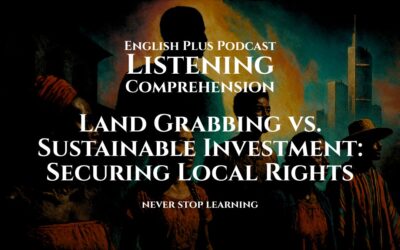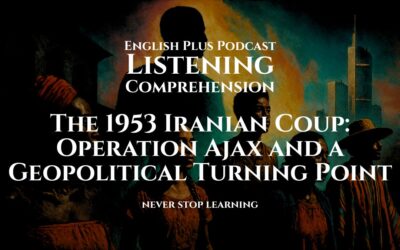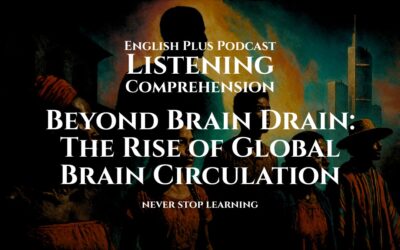Sharpen Your Listening Skills
Welcome to your listening practice exercise. Today’s lecture explores the vital link between education and economic development, a common topic in academic settings. Mastering this type of listening is essential for your exam success, as it tests your ability to understand structured arguments, theoretical concepts, and real-world examples.
Here are some tips to help you focus and comprehend the material effectively:
- Identify the Core Argument: From the beginning, try to figure out the speaker’s central thesis. What is the main relationship they are trying to explain between education and the economy? Every point that follows will likely support this core argument.
- Listen for Key Concepts: The speaker will discuss concepts like “human capital,” “cognitive skills,” and “social returns.” When you hear a term like this, listen carefully for the definition or explanation that is sure to follow. Note it down.
- Distinguish between Micro and Macro Effects: The lecture might discuss the benefits of education for individuals (micro) and for the entire country (macro). Try to keep these two levels separate in your mind and your notes. For example, “higher personal income” is a micro effect, while “increased national GDP” is a macro effect.
- Anticipate Counterarguments or Nuances: An academic lecture rarely presents a one-sided view. Be prepared for the speaker to introduce complexities or challenges. They might use phrases like “However, it’s not that simple…” or “A key challenge is…” This shows a deeper level of analysis.
Let’s begin the lecture.
Listening Audio
Listening Transcript: Please do not read the transcript before you listen and answer the questions.
Good morning. In our session today, we will delve into a cornerstone of development studies: the intricate and powerful relationship between education and economic development. For centuries, economists and policymakers have understood, at least intuitively, that a well-educated populace is a prerequisite for a prosperous nation. However, in the last several decades, rigorous economic research has allowed us to move beyond intuition and quantify this relationship, revealing the multifaceted ways in which education acts as a potent engine for economic growth.
The primary theoretical framework we use to understand this link is the concept of “human capital.” Just as a country can invest in physical capital—factories, machinery, infrastructure—it can also invest in its people. Education is the principal form of investment in human capital. From an individual’s perspective, or the microeconomic level, this investment yields significant private returns. On average, an individual with a higher level of education will earn a substantially higher income over their lifetime. Education imparts specific skills and knowledge that make a worker more productive and thus more valuable to an employer. This is the most direct and easily measured benefit.
However, the story becomes even more compelling when we look at the macroeconomic level—the benefits to society as a whole, which we call social returns. These social returns on education often exceed the private returns. An educated population does more than just earn higher wages; it creates positive externalities, which are benefits that spill over to the rest of society. For instance, a more educated workforce is more innovative. It is better equipped to adopt, adapt, and develop new technologies, which is a fundamental driver of long-term economic growth. An engineer who develops a more efficient irrigation system doesn’t just benefit her company; she benefits the entire agricultural sector.
Furthermore, it’s not just about the quantity of schooling, measured in years. The quality of education is paramount. Recent research has shifted the focus from mere school enrollment rates to the actual cognitive skills a population possesses—their literacy, numeracy, and problem-solving abilities. A country can have high enrollment rates, but if students are not actually learning, the economic benefits will be negligible. This is why international assessments like the PISA tests are so crucial; they provide a benchmark for the quality of educational outcomes, which correlate much more strongly with economic growth than years of schooling alone. A workforce that can think critically and adapt to new challenges is the true asset.
Beyond these direct economic impacts, education generates a host of indirect benefits that are foundational for a stable and growing economy. For example, higher levels of education, particularly for women, are strongly associated with better health outcomes for families and lower fertility rates. Healthier children are more likely to attend school and become productive adults, creating a virtuous cycle. A more educated citizenry is also more likely to participate in civic life, demand better governance, and contribute to political stability—all of which create a more attractive environment for investment and business. This social fabric, woven by education, is an indispensable platform for sustainable economic development.
However, we must approach this with a degree of nuance. Simply pouring money into building schools is not a silver bullet. The effectiveness of education spending is critical. The challenges are formidable, especially for developing nations. These include ensuring equitable access, so that children from rural areas or poor families are not left behind. It includes training and retaining high-quality teachers, who are the lifeblood of any education system. It involves developing curricula that are relevant to the demands of the modern, globalized economy, rather than outdated models.
Moreover, there can be a mismatch between the supply of educated graduates and the demands of the labor market. If a country produces a large number of university graduates in fields where there are no jobs, it can lead to frustration, unemployment, and even social unrest—a phenomenon known as “graduate unemployment.” Therefore, educational planning must be strategically aligned with economic policy and industrial needs to ensure that the skills being taught are the skills that are in demand.
In conclusion, the role of education in economic development is profound and undeniable. It builds human capital, which boosts individual productivity and, more importantly, fosters the innovation and positive externalities that drive national growth. It is the quality of education and the cognitive skills it imparts, not just the years of attendance, that truly matters. While the path is fraught with challenges like ensuring equity, quality, and relevance, investing in education remains the most fundamental and sustainable strategy a country can employ to build a prosperous and stable future. It is not merely an expenditure; it is the ultimate investment in a nation’s potential.
Listening Quiz
Keywords & Phrases
Prerequisite
A thing that is required as a prior condition for something else to happen or exist.
How we used it: A well-educated populace was called a “prerequisite for a prosperous nation.” This means you cannot have a prosperous nation without first having an educated population.
Multifaceted
Having many different aspects or features.
How we used it: The lecture described the “multifaceted ways” education helps the economy. This means it doesn’t just help in one way, but in many different and complex ways.
Human Capital
The skills, knowledge, and experience possessed by an individual or population, viewed in terms of their value or cost to an organization or country.
How we used it: This was a central concept. We discussed education as an investment in “human capital,” treating the collective skill of the workforce as a valuable national asset.
Positive Externalities
A benefit that is enjoyed by a third-party as a result of an economic transaction.
How we used it: We said education creates “positive externalities.” This refers to the “spill-over” benefits to society, like increased innovation, that go beyond the private benefit of a higher salary for the educated individual.
Paramount
More important than anything else; supreme.
How we used it: The speaker stated that the quality of education is “paramount.” This emphasizes that quality is the single most important factor, even more so than the number of years spent in school.
Negligible
So small or unimportant as to be not worth considering; insignificant.
How we used it: We said that if students aren’t actually learning, the economic benefits will be “negligible.” This means the benefits will be too small to even matter.
Virtuous cycle
A chain of events in which one desirable occurrence leads to another which further promotes the first, and so on, resulting in a continuous process of improvement.
How we used it: The link between education and health was called a “virtuous cycle.” Better education for women leads to healthier children, who in turn perform better at school, creating a powerful, positive feedback loop.
A silver bullet
A simple, seemingly magical solution to a complicated problem.
How we used it: The speaker warned that “pouring money into building schools is not a silver bullet.” This idiom means it’s not a simple, magical fix for economic development.
Lifeblood
The indispensable part or force of something.
How we used it: High-quality teachers were called the “lifeblood of any education system.” This metaphor suggests that without good teachers, the system cannot survive or be healthy.
Aligned with
To be in or come into a correct relationship or position; to give support to.
How we used it: The speaker recommended that educational planning must be “aligned with economic policy.” This means the two must be working together in harmony, with the education system producing the skills the economy actually needs.










0 Comments